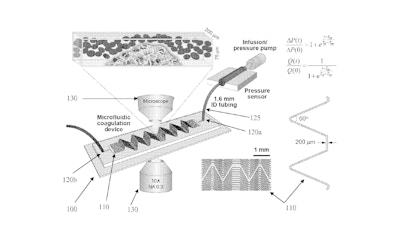Innovations in Nanoparticles, microbe-binding synthetic proteins, CRISPR-Cas9 technology and more
To realize its overarching goal to invent and commercialize disruptive solutions for healthcare, energy, architecture, robotics, and manufacturing, the Wyss Institute is creating a patent portfolio in relevant areas that are or can become an essential basis for specific business development and commercialization efforts. To learn more about these innovations, contact our Business Development Team.
The Wyss Institute’s U.S. patents issued between January and March 2017 are as follows:

Materials presenting notch signaling molecules to control cell behavior
U.S. Patent 9,603,894 (March 28, 2017)
Lan Cao, Kamal H. Bouhadir, and David J. Mooney
Abstract: The invention provides a solution to the problem of delivering molecules in a physiologically relevant manner to direct cell fate. For example, a Notch ligand molecule is presented in a microenvironment that mimics the environment encountered in vivo. Accordingly, the invention features a cell delivery vehicle comprising a biocompatible hydrogel or polymer and a composition that binds to a Notch receptor and methods of directing cell fate, e.g., stem cell differentiation, using such compositions.
Method for forming nanoparticles having predetermined shapes
U.S. Patent 9,598,690 (March 21, 2017)
Wei Sun and Peng Yin
Abstract: Articles and methods for forming nanostructures having unique and/or predetermined shapes are provided. The methods and articles may involve the use of nucleic acid containers as structural molds. For instance, a pre-designed nucleic acid container including a cavity may be used to control the shape-specific growth of nanoparticles. Growth of the nanoparticles within the cavities may be confined by the specific shape of the nucleic acid container. In some embodiments, the resulting nucleic acid-nanoparticle structures can be used to control the orientation and numbers of surface ligands on the surface of nanoparticles. The addressability of the surface ligands can be used to form higher ordered assemblies of the structures.

Engineered microbe-targeting molecules and uses thereof
U.S. Patent 9,593,160 (March 14, 2017)
Donald E. Ingber, Michael Super, Jeffrey Charles Way, Mark J. Cartwright, Julia B. Berthet, Dinah R. Super, Martin M. Rottman, and Alexander Watters
Abstract: Described herein are engineered microbe-targeting or microbe-binding molecules, kits comprising the same and uses thereof. Some particular embodiments of the microbe-targeting or microbe-binding molecules comprise a carbohydrate recognition domain of mannose-binding lectin, or a fragment thereof, linked to a portion of a Fc region. In some embodiments, the microbe-targeting molecules or microbe-binding molecules can be conjugated to a substrate, e.g., a magnetic microbead, forming a microbe-targeting substrate (e.g., a microbe-targeting magnetic microbead). Such microbe-targeting molecules and/or substrates and the kits comprising the same can bind and/or capture of a microbe and/or microbial matter thereof, and can thus be used in various applications, e.g., diagnosis and/or treatment of an infection caused by microbes such as sepsis in a subject or any environmental surface. Microbe-targeting molecules and/or substrates can be regenerated after use by washing with a low pH buffer or buffer in which calcium is insoluble.
Orthogonal Cas9 proteins for RNA-guided gene regulation and editing
U.S. Patent 9,587,252 (March 7, 2017)
George M. Church, Kevin Esvelt, and Prashant Mali
Abstract: Methods of modulating expression of a target nucleic acid in a cell are provided including use of multiple orthogonal Cas9 proteins to simultaneously and independently regulate corresponding genes or simultaneously and independently edit corresponding genes.

Microfluidic device for real-time clinical monitoring and quantitative assessment of whole blood coagulation
U.S. Patent 9,562,914 (February 7, 2017)
Abhishek Jain, Anna Waterhouse, Mike Super, Donald E. Ingber, and Daniel C. Leslie
Abstract: In accord with one aspect, a microfluidic coagulation assessment device defining a plurality of microchannels is provided, wherein a blood sample is driven through the microchannels at a substantially constant flow rate and a controller is configured to, in combination with a timer and a pressure sensing device, determine a first pressure value (or flow value) at an initiation of flow, a first time (Tpg) at which a second pressure value is about twice the determined first pressure value, and a second time (Tpf) at which a third pressure value is about (1+e) times the determined first pressure value and establish a subject coagulation model predictive of channel occlusion therefrom. In another aspect, the blood sample is driven through the microchannels at a substantially constant pressure and a controller is configured to, in combination with a timer and a flow sensing device make the determination based on flow rate.
Riboregulator compositions and methods of use
U.S. Patent 9,550,987 (January 24, 2017)
Alexander A. Green, Peng Yin, and James J. Collins
Abstract: The invention provides novel and versatile classes of riboregulators, including inter alia activating and repressing riboregulators, switches, and trigger and sink RNA, and methods of their use for detecting RNAs in a sample such as a well and in modulating protein synthesis and expression.
